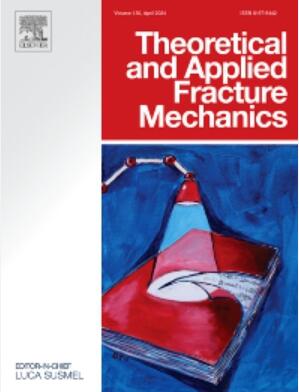An improved phase-field model for fatigue crack growth considering constraint effects
IF 5
2区 工程技术
Q1 ENGINEERING, MECHANICAL
引用次数: 0
Abstract
The phase field model is a promising method for simulating fatigue crack growth (FCG) behavior. However, the conventional phase field (PF) model may not adequately account for constraint effects, where fracture toughness is affected by geometries. Therefore, stress triaxiality is incorporated into the PF model by modifying the fracture energy release rates to consider constraint effects. The model successfully simulates the FCG behavior of different geometries, such as CT, SENB, and MT specimens, as well as the mixed-mode FCG behavior of CTS specimens and other complex geometries. All simulations agree well with experiments, proving that our model is capable to capture the constraint effects in FCG behavior. These findings indicate that stress triaxiality is important to capture the constraint effects.
考虑约束效应的疲劳裂纹增长改进相场模型
相场模型是模拟疲劳裂纹生长(FCG)行为的一种很有前途的方法。然而,传统的相场(PF)模型可能无法充分考虑约束效应,因为断裂韧性会受到几何形状的影响。因此,通过修改断裂能量释放率,将应力三轴性纳入 PF 模型,以考虑约束效应。该模型成功模拟了不同几何形状的 FCG 行为,如 CT、SENB 和 MT 试样,以及 CTS 试样和其他复杂几何形状的混合模式 FCG 行为。所有模拟结果都与实验结果吻合,证明我们的模型能够捕捉 FCG 行为中的约束效应。这些发现表明,应力三轴性对于捕捉约束效应非常重要。
本文章由计算机程序翻译,如有差异,请以英文原文为准。
求助全文
约1分钟内获得全文
求助全文
来源期刊

Theoretical and Applied Fracture Mechanics
工程技术-工程:机械
CiteScore
8.40
自引率
18.90%
发文量
435
审稿时长
37 days
期刊介绍:
Theoretical and Applied Fracture Mechanics'' aims & scopes have been re-designed to cover both the theoretical, applied, and numerical aspects associated with those cracking related phenomena taking place, at a micro-, meso-, and macroscopic level, in materials/components/structures of any kind.
The journal aims to cover the cracking/mechanical behaviour of materials/components/structures in those situations involving both time-independent and time-dependent system of external forces/moments (such as, for instance, quasi-static, impulsive, impact, blasting, creep, contact, and fatigue loading). Since, under the above circumstances, the mechanical behaviour of cracked materials/components/structures is also affected by the environmental conditions, the journal would consider also those theoretical/experimental research works investigating the effect of external variables such as, for instance, the effect of corrosive environments as well as of high/low-temperature.
 求助内容:
求助内容: 应助结果提醒方式:
应助结果提醒方式:


